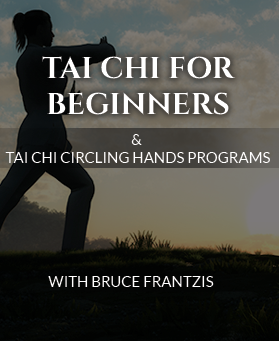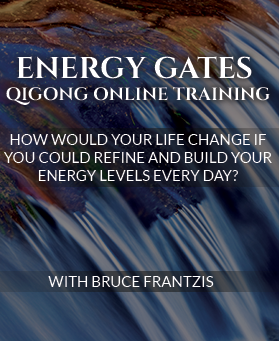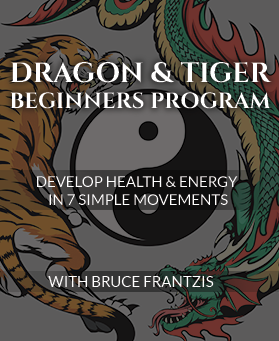Bagua (Bagua/Pakua) has two main traditions. In the West, the better known is its martial art tradition, usually called bagua zhang. Less well known is its spiritual or monastic tradition. This post explores the spiritual tradition of bagua and how it can be used for meditation and as a spiritual practice.
Taoist Bagua Monastic Tradition
Over time, pieces of the story of the possible origins of bagua as a spiritual tradition have emerged. One of the most intriguing involves a Taoist temple in the south of China, Dragon Gate in Jiangxi Province. Monks there have been practicing the Single Palm Change for 1,500 years. They don’t practice bagua as a martial art, but purely as neigong or internal energy cultivation exercise and spiritual practice.
This monastery also has records of bagua coming from Shansi Province in Northern China. In Shansi, other records reveal that bagua comes from the Kunlun Mountains, which are north of the Himalayas.
Bai Hua, my teacher Liu Hung Chieh’s disciple in the Taoist Fire tradition, gave me this information. Bai Hua visited Dragon Gate temple to verify these reports. Liu saw records in Shansi Province before the Communist Revolution and said the records were subsequently destroyed during the Cultural Revolution.
The Spiritual Traditions of Bagua and the I Ching
According to Liu, Bagua Circle Walking—developed by monks some 4,000 years ago—had four intertwined purposes:
- To generate a healthy, disease-free body with relaxed nerves and great stamina, which the monks needed for daily work and prolonged meditation.
- To achieve stillness of mind.
- To develop and maintain balance internally while either the monk’s inner world or the events of the external world were changing.
- To realize the Tao.
In the monastic tradition, bagua had one primary technique: the Single Palm Change. It evolved from the bagua circle-walking practice.
Various bagua qigong postures serve as preparation for performing the primary exercise itself. You hold your arms motionless in space whether or not the feet are moving. While maintaining the posture, the aim is to bring chi from the belly and spine to the fingertips and stabilize the internal alignments of the upper body.
Once the neigong of specific bagua qigong postures has been integrated, the Single Palm Change proves sufficient to allow practitioners to develop and manipulate the energies inside their body, join them with those outside their body and eventually connect directly to the eight energies of change mapped by the I Ching.
8 Energies of the I Ching
The eight universal energies of the I Ching are:
- Water
- Thunder
- Wind
- Fire
- Earth
- Mountain
- Lake
- Heaven
Taoists believe that the whole of the universe is represented and present inside every human being’s body. The mind of a human being is therefore capable of manipulating the eight energies since they exist inside the body. With practice you could take this to the point of intimately resonating with the energies of the universe that are outside your body. Toward this end, Taoists developed meditation methods.
Using the I Ching as a practical guide, bagua and tai chi are two methods developed by Taoists for exploring and balancing the eight universal energies within and outside of the body. You start physically with chi exercises, such as qigong, bagua or tai chi to clear blockages and make the body stable in the first four energy bodies (physical body, etheric body, mental body and emotional body). You progress to more sophisticated movements and meditation methods to clear and balance the energies in the remaining four energy bodies.
As you balance the energies within you, compassion and naturalness follow. By developing the experiential ability to simultaneously delve inside your body and yet directly experience that which is outside of your body, you gain an understanding of universal energies and how they work.
One of the core methods that Taoists developed to actualize these practices is the Bagua Single Palm Change.
More importantly, those who penetrate even more deeply into the I Ching eventually discover that which does not change and remains constant throughout the universe. While the eight energies endlessly combine and recombine—going through alchemical transformations and transmutations—the Tao never changes.
5 Energetic Practice Elements for Meditation
There are five particularly important elements in the practice of bagua (pakua) and tai chi (taiji) as arts of developing chi for health or meditation. As all five come into play, in an aggregate, synergistic fashion they cause all the fluids of the body to circulate evenly and powerfully, including the blood and interstitial fluids between the cells.
1. Spiraling Energy
You want to develop a spiraling or twisting energy that involves all parts of the body, including the abdominal cavity, internal organs, bone marrow, tendons, ligaments, muscles and the deepest layers of fascia. Sometimes the external twisting actions are obvious. Others occur so deeply within the body as to give minimal visual clues to those not thoroughly trained to specifically recognize them.
2. Six Combinations of the Body
Physically, a focus on the six combinations of the body (liu he in Chinese), refers to the three external pairs of combinations: the elbow with the knee; the hand with the foot; and the shoulder with the hip. Each coordinates with the other through the center core of the body.
The three internal combinations—intention, energy and consciousness—must coordinate with one another as well as with the three external combinations of the physical body. The object is to make the whole physical body, chi and mind move like one totally integrated cell without disconnected moving parts.
3. Body Systems Connect to the Spine
You want your movements to incorporate all the body systems connected to the spine. This process maximizes the strength and flexibility of the spinal column, helps to heal spinal injuries and develops the central nervous system’s sensitivity, strength and stamina. Bagua and tai chi move the vertebrae of the spine continuously, powerfully pumping cerebrospinal fluid through the system.
4. Opening and Closing
You want to develop opening and closing (pulsing) in the joints and cavities of the body, including the expansion and compression of the synovial fluid within the joints. The openings and closings help free up the body’s energy flows.
5. Energy Channels of the Body
An essential goal is to open the major energy channels of the body, and there are a lot of them (4,000-5,000). The most important three are the central, left and right channels.
Other important energy channels include the body’s yin and yang acupuncture meridians. Yin meridians run along the inside of the arms and legs and along the front of the body. The yang meridians run along the outside of the legs, along the back and on the outside of the arms.
There are also the acupuncture meridians that circle your body in the manner of connective belts (jing luo). Other important meridians include what are referred to as the eight special or extraordinary meridians. All these channels are opened and joined through the moving practices of bagua and tai chi.





Excellent way of describing, and nice paragraph to take facts about my presentation topic,
which i am going to deliver in school.
Thank you for your post! I learned a lot. I practice Energy Bagua as taught by Grandmaster JinBodhi, which I think is similar to the single palm change form. I loved reading your explanations of Bagua circling.
Thank you for the excellent explanation! This helps a lot.